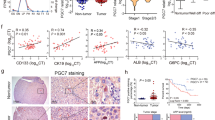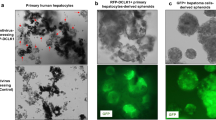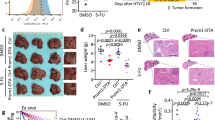Abstract
Cellular plasticity has an important role in the progression of hepatocellular carcinoma (HCC). In this study, the involvement of a TGF-β1-CD147 self-sustaining network in the regulation of the dedifferentiation progress was fully explored in HCC cell lines, hepatocyte-specific basigin/CD147-knockout mice and human HCC tissues. We demonstrated that TGF-β1 stimulation upregulated CD147 expression and mediated the dedifferentiation of HCC cells, whereas all-trans-retinoic acid induced the downregulation of CD147 and promoted differentiation in HCC cells. Overexpression of CD147 induced the dedifferentiation and enhanced the malignancy of HCC cells, and increased the transcriptional expression of TGF-β1 by activating β-catenin. CD147-induced matrix metalloproteinase (MMP) production activated pro-TGF-β1. The activated TGF-β1 signaling subsequently repressed the HNF4α expression via Smad-Snail1 signaling and enhanced the dedifferentiation progress. Hepatocyte-specific basigin/CD147-knockout mice decreased the susceptibility to N-nitrosodiethylamine-induced tumorigenesis by suppressing TGF-β1-CD147 signaling and inhibiting dedifferentiation in hepatocytes during tumor progression. CD147 was positively correlated with TGF-β1 and negatively correlated with HNF4α in human HCC tissues. Positive CD147 staining and lower HNF4α levels in tumor tissues were significantly associated with poor survival of patients with HCC. The overexpression of HNF4α and Smad7 and the deletion of CD147 by lentiviral vectors jointly reprogrammed the expression profile of hepatocyte markers and attenuated malignant properties including proliferation, cell survival and tumor growth of HCC cells. Our results highlight the important role of the TGF-β1-CD147 self-sustaining network in driving HCC development by regulating differentiation plasticity, which provides a strong basis for further investigations of the differentiation therapy of HCC targeting TGF-β1 and CD147.
This is a preview of subscription content, access via your institution
Access options
Subscribe to this journal
Receive 50 print issues and online access
$259.00 per year
only $5.18 per issue
Buy this article
- Purchase on Springer Link
- Instant access to full article PDF
Prices may be subject to local taxes which are calculated during checkout








Similar content being viewed by others
References
Tschaharganeh DF, Xue W, Calvisi DF, Evert M, Michurina TV, Dow LE et al. p53-dependent Nestin regulation links tumor suppression to cellular plasticity in liver cancer. Cell 2014; 158: 579–592.
Salomao M, McMillen E, Lefkowitch JH . Recent advances in the classification of hepatocellular carcinoma. Diagn Histopathol 2012; 18: 37–45.
Kumar SM, Liu S, Lu H, Zhang H, Zhang PJ, Gimotty PA et al. Acquired cancer stem cell phenotypes through Oct4-mediated dedifferentiation. Oncogene 2012; 31: 4898–4911.
Ulianich L, Garbi C, Treglia AS, Punzi D, Miele C, Raciti GA et al. ER stress is associated with dedifferentiation and an epithelial-to-mesenchymal transition-like phenotype in PC CI3 thyroid cells. J Cell Sci 2008; 121: 477–486.
Godoy P, Hengstler JG, Ilkavets I, Meyer C, Bachmann A, Müller A et al. Extracellular matrix modulates sensitivity of hepatocytes to fibroblastoid dedifferentiation and transforming growth factor β-induced apoptosis. Hepatology 2009; 49: 2031–2043.
Chui MH . Insights into cancer metastasis from a clinic opathologic perspective: epithelial-mesenchymal transition is not a necessary step. Int J Cancer 2013; 132: 1487–1495.
Zulehner G, Mikula M, Schneller D, van Zijl F, Huber H, Sieghart W et al. Nuclear beta-catenin induces an early liver progenitor phenotype in hepatocellular carcinoma and promotes tumor recurrence. Am J Pathol 2010; 176: 472–478.
Derynck R, Akhurst RJ . Differentiation plasticity regulated by TGF-beta family proteins in development and disease. Nat Cell Biol 2007; 9: 1000–1004.
Wei Q, Chen ZH, Wang L, Zhang T, Duan L, Behrens C et al. LZTFL1 suppresses lung tumorigenesis by maintaining differentiation of lung epithelial cells. Oncogene 2016; 35: 2655–2663.
Lazarevich NL, Cheremnova OA, Varga EV, Ovchinnikov DA, Kudrjavtseva EI, Morozova OV et al. Progression of HCC in mice is associated with a downregulation in the expression of hepatocyte nuclear factors. Hepatology 2004; 39: 1038–1047.
Walesky C, Edwards G, Borude P, Gunewardena S, O'Neil M, Yoo B et al. Hepatocyte nuclear factor 4 alpha deletion promotes diethylnitrosamine-induced hepatocellular carcinoma in rodents. Hepatology 2013; 57: 2480–2490.
Yin C, Lin Y, Zhang X, Chen YX, Zeng X, Yue HY et al. Differentiation therapy of hepatocellular carcinoma in mice with recombinant adenovirus carrying hepatocyte nuclear factor-4alpha gene. Hepatology 2008; 48: 1528–1539.
Pisco AO, Huang S . Non-genetic cancer cell plasticity and therapy-induced stemness in tumour relapse: ‘What does not kill me strengthens me’. Br J Cancer 2015; 112: 1725–1732.
Meyer C, Liu Y, Kaul A, Peipe I, Dooley S . Caveolin-1 abrogates TGF-β mediated hepatocyte apoptosis. Cell Death Dis 2013; 4: e466.
Zhang H, Wu H, Zheng J, Yu P, Xu L, Jiang P et al. Transforming growth factor β1 signal is crucial for dedifferentiation of cancer cells to cancer stem cells in osteosarcoma. Stem Cells 2013; 31: 433–446.
Wu K, Ding J, Chen C, Sun W, Ning BF, Wen W et al. Hepatic transforming growth factor beta gives rise to tumor-initiating cells and promotes liver cancer development. Hepatology 2012; 56: 2255–2267.
Cozzolino AM, Alonzi T, Santangelo L, Mancone C, Conti B, Steindler C et al. TGFβ overrides HNF4α tumor suppressing activity through GSK3β inactivation: implication for hepatocellular carcinoma gene therapy. J Hepatol 2013; 58: 65–72.
Makarova-Rusher OV, Medina-Echeverz J, Duffy AG, Greten TF . The yin and yang of evasion and immune activation in HCC. J Hepatol 2015; 62: 1420–1429.
Giannelli G, Villa E, Lahn M . Transforming growth factor-β as a therapeutic target in hepatocellular carcinoma. Cancer Res 2014; 74: 1890–1894.
Wu J, Ru NY, Zhang Y, Li Y, Wei D, Ren Z et al. HAb18G/CD147 promotes epithelial-mesenchymal transition through TGF-β signaling and is transcriptionally regulated by Slug. Oncogene 2011; 30: 4410–4427.
Zhao P, Zhang W, Wang SJ, Yu XL, Tang J, Huang W et al. HAb18G/CD147 promotes cell motility by regulating annexin II-activated RhoA and Rac1 signaling pathways in hepatocellular carcinoma cells. Hepatology 2011; 54: 2012–2024.
Tang J, Guo YS, Zhang Y, Yu XL, Li L, Huang W et al. CD147 induces UPR to inhibit apoptosis and chemosensitivity by increasing the transcription of Bip in hepatocellular carcinoma. Cell Death Differ 2012; 19: 1779–1790.
Zhu D, Wang Z, Zhao JJ, Calimeri T, Meng J, Hideshima T et al. The Cyclophilin A-CD147 complex promotes the proliferation and homing of multiple myeloma cells. Nat Med 2015; 21: 572–580.
Khayati F, Pérez-Cano L, Maouche K, Sadoux A, Boutalbi Z, Podgorniak MP et al. EMMPRIN/CD147 is a novel coreceptor of VEGFR-2 mediating its activation by VEGF. Oncotarget 2015; 6: 9766–9780.
Zhang Y, Guan DX, Shi J, Gao H, Li JJ, Zhao JS et al. All-trans retinoic acid potentiates the chemotherapeutic effect of cisplatin by inducing differentiation of tumor initiating cells in liver cancer. J Hepatol 2013; 59: 1255–1263.
Kim SC, Kim CK, Axe D, Cook A, Lee M, Li T et al. All-trans-retinoic acid ameliorates hepatic steatosis in mice by a novel transcriptional cascade. Hepatology 2014; 59: 1750–1760.
Lu M, Wu J, He F, Wang XL, Li C, Chen ZN et al. Cell expression patterns of CD147 in N-diethylnitrosamine/phenobarbital-induced mouse hepatocellular carcinoma. J Mol Histol 2015; 46: 79–91.
Bitting RL, Schaeffer D, Somarelli JA, Garcia-Blanco MA, Armstrong AJ . The role of epithelial plasticity in prostate cancer dissemination and treatment resistance. Cancer Metastasis Rev 2014; 33: 441–468.
Zeng X, Lin Y, Yin C, Zhang X, Ning BF, Zhang Q et al. Recombinant adenovirus carrying the hepatocyte nuclear factor-1alpha gene inhibits hepatocellular carcinoma xenograft growth in mice. Hepatology 2011; 54: 2036–2047.
Sun B, Gao Y, Deng L, Li G, Cheng F, Wang X . The level of oncogene H-Ras correlates with tumorigenicity and malignancy. Cell Cycle 2008; 7: 934–939.
Grusch M, Petz M, Metzner T, Oztürk D, Schneller D, Mikulits W . The crosstalk of RAS with the TGF-β family during carcinoma progression and its implications for targeted cancer therapy. Curr Cancer Drug Targets 2010; 10: 849–857.
Liu Y, Ye X, Zhang JB, Ouyang H, Shen Z, Wu Y et al. PROX1 promotes hepatocellular carcinoma proliferation and sorafenib resistance by enhancing β-catenin expression and nuclear translocation. Oncogene 2015; 34: 5524–5535.
Suzuki T, Yano H, Nakashima Y, Nakashima O, Kojiro M . Beta-catenin expression in hepatocellular carcinoma: a possible participation of beta-catenin in the dedifferentiation process. J Gastroenterol Hepatol 2002; 17: 994–1000.
Sidhu SS, Nawroth R, Retz M, Lemjabbar-Alaoui H, Dasari V, Basbaum C . EMMPRIN regulates the canonical Wnt/beta-catenin signaling pathway, a potential role in accelerating lung tumorigenesis. Oncogene 2010; 29: 4145–4156.
Kessenbrock K, Plaks V, Werb Z . Matrix metalloproteinases: regulators of the tumor microenvironment. Cell 2010; 141: 52–67.
Varga J, De Oliveira T, Greten FR . The architect who never sleeps: tumor-induced plasticity. FEBS Lett 2014; 588: 2422–2427.
Nieto MA . Epithelial plasticity: a common theme in embryonic and cancer cells. Science 2013; 342: 1234850.
Medema JP . Cancer stem cells: the challenges ahead. Nat Cell Biol 2013; 15: 338–344.
Cicchini C, Amicone L, Alonzi T, Marchetti A, Mancone C, Tripodi M . Molecular mechanisms controlling the phenotype and the EMT/MET dynamics of hepatocyte. Liver Int 2015; 35: 302–310.
Santangelo L, Marchetti A, Cicchini C, Conigliaro A, Conti B, Mancone C et al. The stable repression of mesenchymal program is required for hepatocyte identity: a novel role for hepatocyte nuclear factor 4alpha. Hepatology 2011; 53: 2063–2074.
Cicchini C, de Nonno V, Battistelli C, Cozzolino AM, De Santis Puzzonia M, Ciafrè SA et al. Epigenetic control of EMT/MET dynamics: HNF4α impacts DNMT3s through miRs-29. Biochim Biophys Acta 2015; 1849: 919–929.
Ye X, Weinberg RA . Epithelial-mesenchymal plasticity: a central regulator of cancer progression. Trends Cell Biol 2015; 25: 675–686.
Giannelli G, Mazzocca A, Fransvea E, Lahn M, Antonaci S . Inhibiting TGF-β signaling in hepatocellular carcinoma. Biochim Biophys Acta 2011; 1815: 214–223.
Gumireddy K, Li A, Gimotty PA, Klein-Szanto AJ, Showe LC, Katsaros D et al. KLF17 is a negative regulator of epithelial-mesenchymal transition and metastasis in breast cancer. Nat Cell Biol 2009; 11: 1297–1304.
Chakrabarti R, Hwang J, Andres Blanco M, Wei Y, Lukačišin M, Romano RA et al. Elf5 inhibits the epithelial-mesenchymal transition in mammary gland development and breast cancer metastasis by transcriptionally repressing Snail2. Nat Cell Biol 2012; 14: 1212–1222.
Brabletz S, Brabletz T . The ZEB/miR-200 feedback loop—a motor of cellular plasticity in development and cancer? EMBO Rep 2010; 11: 670–677.
Ber S, Lee C, Voiculescu O, Surani MA . Dedifferentiation of foetal CNS stem cells to mesendoderm-like cells through an EMT process. PLoS One 2012; 7: e30759.
Tam WL, Weinberg RA . The epigenetics of epithelial-mesenchymal plasticity in cancer. Nat Med 2013; 19: 1438–1449.
Nguyen DX, Bos PD, Massagué J . Metastasis: from dissemination to organ-specific colonization. Nat Rev Cancer 2009; 9: 274–284.
Greaves M, Maley CC . Clonal evolution in cancer. Nature 2012; 481: 306–313.
Janiszewska M, Polyak K . Clonal evolution in cancer: a tale of twisted twines. Cell Stem Cell 2015; 16: 11–12.
Ghajar CM, Peinado H, Mori H, Matei IR, Evason KJ, Brazier H et al. The perivascular niche regulates breast tumour dormancy. Nat Cell Biol 2013; 15: 807–817.
Erez N . Cancer: angiogenic awakening. Nature 2013; 500: 37–38.
Dow LE, O'Rourke KP, Simon J, Tschaharganeh DF, van Es JH, Clevers H et al. Apc restoration promotes cellular differentiation and reestablishes crypt homeostasis in colorectal cancer. Cell 2015; 161: 1539–1552.
Frank NY, Schatton T, Frank MH . The therapeutic promise of the cancer stem cell concept. J Clin Invest 2010; 120: 41–50.
Yao H, Teng Y, Sun Q, Xu J, Chen YT, Hou N et al. Important functional roles of basigin in thymocyte development and T cell activation. Int J Biol Sci 2013; 10: 43–52.
Acknowledgements
We thank professor Mien-Chie Hung (Department of Molecular and Cellular Oncology, University of Texas MD Anderson Cancer Center, Houston, TX, USA) for providing pEGFP-Snail1, and we thank professor Ye-Guang Chen (School of Life Science, Tsinghua University) for providing pcDNA-Flag-Smad7. This work was supported by grants from the National Natural Science Foundation of China (No. 31401222, 31571434, 31401190 and 81172144) and the National Science and Technology Major Project (No. 2012ZX10002-015, 2012AA020806 and 2015CB553701).
Author information
Authors and Affiliations
Corresponding authors
Ethics declarations
Competing interests
The authors declare no conflict of interest.
Additional information
Supplementary Information accompanies this paper on the Oncogene website
Rights and permissions
About this article
Cite this article
Wu, J., Lu, M., Li, Y. et al. Regulation of a TGF-β1-CD147 self-sustaining network in the differentiation plasticity of hepatocellular carcinoma cells. Oncogene 35, 5468–5479 (2016). https://doi.org/10.1038/onc.2016.89
Received:
Revised:
Accepted:
Published:
Issue Date:
DOI: https://doi.org/10.1038/onc.2016.89
This article is cited by
-
Rs6757 in microRNA-3976 binding site of CD147 confers risk of hepatocellular carcinoma in South Chinese population
World Journal of Surgical Oncology (2022)
-
Active demethylation upregulates CD147 expression promoting non-small cell lung cancer invasion and metastasis
Oncogene (2022)
-
CD147 contributes to SARS-CoV-2-induced pulmonary fibrosis
Signal Transduction and Targeted Therapy (2022)
-
Cancer stemness in hepatocellular carcinoma: mechanisms and translational potential
British Journal of Cancer (2020)



